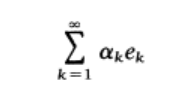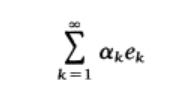You are using an out of date browser. It may not display this or other websites correctly.
You should upgrade or use an alternative browser.
You should upgrade or use an alternative browser.
A functional analysis problem related to representation by orthonormal sequence in a Hilbert space
- Thread starter zzzhhh2
- Start date
D
Deleted member 4993
Guest
Since you are stuck at the "very beginning" and thus we must start with definitions:This is a problem in text "Introductory Functional Analysis with Applications" by Erwin Kreyszig, Sec. 3.5:
View attachment 21053
where (6) is
View attachment 21054
I'm stuck at very beginning so I don't know how to start. Any help would be appreciated, especially the solution that follows the contents of this textbook. Thank you.
What is a orthonormal sequence (in a Hilbert space)? What are its characteristics (properties)?
Can you expand (first three terms of) \(\displaystyle \sum_{k=1}^{\infty}\alpha_{k}e_{k}\)?
Where [6] is:

Last edited by a moderator:
Thanks for the reply. The orthonormal sequence is defined in the middle of P152 of the text. It has many properties. Can you let me know which property is relevant to this problem?
The first 3 terms of the series (6) is \alpha_1 e_1, \alpha_1 e_1+\alpha_2 e_2, \alpha_1 e_1+\alpha_2 e_2 +\alpha_3 e_3. (PS: does this website support Latex?)
As a side note, I have read the text (like Sec. 3.5) but can not find useful hints from it. The main reason I have interest in this problem is Theorem 3.5-2 (c). It says the series (6) converges, but does not mention to what it converges. At first glance, I guess it converges to x. But I cannot find support in the proof to establish that. When I saw this problem, it seems that my original guess is wrong. If x is not in the closure of span M, series (6) does not converges to x (though the theorem confirms its convergence). The following sections like Sec. 3.6 does not help because it is discussing total orthonormal sequence which makes the iff always true. Furthermore, I have a question about the relation between (total) orthonormal sequence and Schauder basis: does the existence of (total) orthonormal sequence necessarily imply the existence of Schauder basis? (is the total orthonormal sequence just the Schauder basis? If not, under what condition could they be the same? If the answer is no, is there any way to derive Schauder basis from total orthonormal sequence?) I hope I can answer myself after I am able to solve this problem. Of course if I cannot, I will ask here for help.
The first 3 terms of the series (6) is \alpha_1 e_1, \alpha_1 e_1+\alpha_2 e_2, \alpha_1 e_1+\alpha_2 e_2 +\alpha_3 e_3. (PS: does this website support Latex?)
As a side note, I have read the text (like Sec. 3.5) but can not find useful hints from it. The main reason I have interest in this problem is Theorem 3.5-2 (c). It says the series (6) converges, but does not mention to what it converges. At first glance, I guess it converges to x. But I cannot find support in the proof to establish that. When I saw this problem, it seems that my original guess is wrong. If x is not in the closure of span M, series (6) does not converges to x (though the theorem confirms its convergence). The following sections like Sec. 3.6 does not help because it is discussing total orthonormal sequence which makes the iff always true. Furthermore, I have a question about the relation between (total) orthonormal sequence and Schauder basis: does the existence of (total) orthonormal sequence necessarily imply the existence of Schauder basis? (is the total orthonormal sequence just the Schauder basis? If not, under what condition could they be the same? If the answer is no, is there any way to derive Schauder basis from total orthonormal sequence?) I hope I can answer myself after I am able to solve this problem. Of course if I cannot, I will ask here for help.

